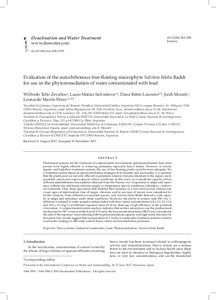Please use this identifier to cite or link to this item:
https://repositorio.uca.edu.ar/handle/123456789/9006| Título: | Evaluation of the autochthonous free-floating macrophyte Salvinia biloba Raddi for use in the phytoremediation of water contaminated with lead | Autor: | Tello Zevallosa, Wilfredo Salvatierra, Lucas Matías Loureiro, Dana Belén Morató Farreras, Jordi Pérez, Leonardo Martín |
Palabras clave: | METALES PESADOS; AGUAS RESIDUALES; FITORREMEDIACION; CONTAMINACION AMBIENTAL; MEDIO AMBIENTE; INGENIERIA AMBIENTAL | Fecha de publicación: | 2018 | Editorial: | Desalination | Cita: | Tello Zevallosa, W. Salvatierra, L.M. Loureiroa, D.B. Morató, J. Pérez, L.M. Evaluation of the autochthonous free-floating macrophyte Salvinia biloba Raddi for use in the phytoremediation of water contaminated with lead [en línea]. Desalination and Water Treatment. 2018, 103. doy: 10.5004/dwt.2018.21709. Disponible en: https://repositorio.uca.edu.ar/handle/123456789/9006 | Resumen: | Abstract: Plant-based systems for the treatment of contaminated environments (phytoremediation) have been proved to be highly efficient in removing pollutants, especially heavy metals. However, in strictly aquatic and high-flow treatment systems, the use of free floating plants could be more adequate. For a treatment system based on phytoremediation strategies to be feasible and sustainable, it is essential that the plants used are not only efficient in pollutants removal, but also abundant in the region, easily accessible, and do not require special culture conditions. In this work, we evaluate the capacity of four different autochthonous macrophytes obtained from the Paraná river (Argentina) to adapt and reproduce without any additional nutrient supply or temperature special conditions (laboratory «indoor» environment). Only those specimens that doubled their biomass in a two-week period without any visual signs of deterioration (loss of turgor, chlorosis and/or necrosis of leaves) were considered for further analysis. From different pre-selected species, only Salvinia biloba Raddi showed a wide capacity to adapt and reproduce under these conditions. Moreover, the ability to remove lead (Pb2+) by S. bilobawas evaluated in water samples contaminated with three metal concentrations (4.8 ± 0.3, 9.1 ± 0.4 and 19.6 ± 0.5 mg/L) at different exposure times (0–24 h), showing a high efficiency in the pollutant elimination. A compartmentalization analysis indicates that surface adsorption was the predominant mechanism for Pb2+ removal at the first 24 h. Finally, the bioconcentration factor (BCF) was calculated at the end of the exposure time,reflecting both hyperaccumulation capacity and high metal tolerance by this plant. Our results suggest that incorporation of S. biloba in wastewater treatment systems could be a successful strategy to efficiently remove heavy metals by bioremediation processes. | URI: | https://repositorio.uca.edu.ar/handle/123456789/9006 | ISSN: | 1944-3994 | Disciplina: | INGENIERIA AMBIENTAL | DOI: | 10.5004/dwt.2018.21709 | Derechos: | Acceso abierto | Fuente: | Desalination and Water Treatment. No.103, 2018. |
| Appears in Collections: | Artículos |
Files in This Item:
| File | Description | Size | Format | |
|---|---|---|---|---|
| evaluation-autochthonous-free-floating.pdf | 269,22 kB | Adobe PDF |  View/Open |
Page view(s)
219
checked on Apr 30, 2024
Download(s)
240
checked on Apr 30, 2024
Google ScholarTM
Check
Altmetric
Altmetric
This item is licensed under a Creative Commons License

